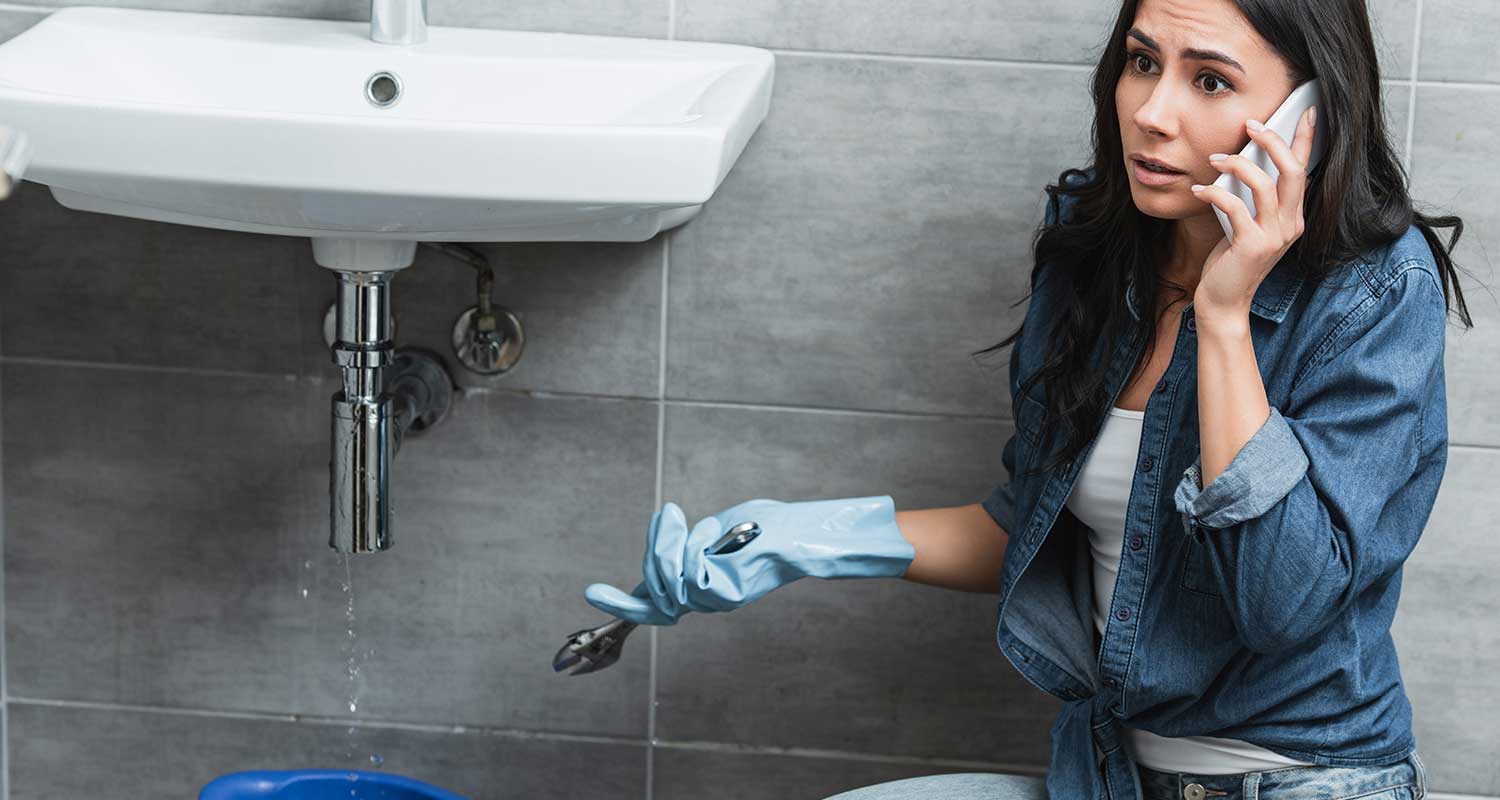Why a Leaky Faucet Should Never Be Ignored
A leaky faucet might seem minor, but every single drip adds up. A dripping faucet can waste thousands of gallons each year, increasing your utility bills and stressing your plumbing system. The constant dripping water also leads to mineral buildup around the faucet spout, which can stain surfaces and damage components over time.
Ignoring a leaking faucet can cause the valve seat and inner valve stem to corrode. Once the valve body or brass valve stem becomes worn, water begins to escape through small cracks and gaps. Fixing a small faucet drip early prevents larger plumbing issues and keeps your water usage under control.
1. Worn Out Washers
The most common reason a faucet leaks is a worn out washer. In compression faucets, the rubber washers press against the valve seat every time you turn the handles to stop the water flow. Friction and constant pressure wear these washers down until water starts seeping through.
A leaky faucet with a slow drip from the faucet spout often points to this issue.
Fixing the Washer
- Turn off the shutoff valves beneath the sink to stop the water supply.
- Remove the decorative cap and the handle screws with a flathead screwdriver.
- Unscrew the stem screw with an adjustable wrench and pull the valve stem straight out.
- Take the old washer to a local hardware store to find a perfect match.
- Replace it, reassemble the faucet structure, and turn the main water supply back on.
If you still notice a faucet drip, the valve seat connects may be deteriorated or corroded.
2. Damaged O-Rings
Inside most newer faucets, an O-ring helps seal the valve stem to prevent leaks around the faucet handles. Over time, these small rubber rings dry out or break. A worn or cracked O-ring allows water to leak from the base of the handle when the faucet is on or off.
You can usually replace an O-ring without changing the entire faucet. Look for a model-specific ring that fits your faucet model. If your faucet continues to leak, inspect other replacement parts like the packing nut or outlet seals.
3. Corroded Valve Seat
The valve seat connects the faucet spout to the valve body and acts as a sealing surface. Hard water, water sediments, and mineral buildup can lead to corroded valve seats, preventing the faucet from sealing completely.
A leaky spout or water pooling near the base often indicates a deteriorated valve seat.
Fixing a Corroded Valve Seat
- Remove the valve stem and inspect the valve seat for corrosion.
- If buildup is visible, pour white vinegar into the seat area and let it soak for several minutes.
- Gently scrub the area with a brush to remove mineral buildup.
- If the seat is severely damaged, replace it using a seat wrench or contact a professional plumber for a full faucet repair.
Routine cleaning of the valve seat prevents future corrosion and extends the life of your faucet.
4. Loose or Broken Parts
Constant use, vibrations, and changes in water pressure can loosen internal components of your faucet. Loose or broken parts inside the faucet structure can cause inconsistent water flow or leaking at the handle base.
Tighten the packing nut or stem screw gently with an adjustable wrench. Avoid over-tightening, which can strip threads or crack the cylindrical body of the faucet.
If tightening does not stop the leak, inspect the valve stem, O-rings, or rubber washers for worn or corroded parts that may need replacement.
5. High Water Pressure
If your home’s water pressure is too high, it can cause a leaky faucet even when everything inside is installed properly. Excessive water pressure forces water through the smallest gaps, leading to persistent dripping.
You can test your water supply pressure with a gauge from a local hardware store. The reading should stay between 40 and 60 PSI. If the pressure is higher, adjust your water pressure regulator or contact a plumbing service to balance it.
High pressure not only worsens faucet leaks but also shortens the life of standard fixtures, ball joints, and ceramic disk faucets.
6. Faulty Cartridge or Ceramic Disk
Cartridge faucets and ceramic disk faucets use internal seals to control water flow. If the entire cartridge or ceramic disk becomes blocked with sediment or damaged, the faucet will drip from the spout even when off.
A cartridge style faucet is common in single lever designs. The cartridge sits inside the cylindrical body and moves to mix hot and cold water. When water sediments or debris scratch its surface, the faucet loses its seal and starts leaking.
Fixing a Cartridge Leak
- Turn off the main water supply.
- Remove the rounded cap and lift out the handle.
- Pull the entire cartridge straight out using pliers.
- Soak the part in white vinegar to dissolve mineral buildup.
- If cleaning does not work, replace it with a matching part for your faucet model.
Proper cleaning and fitting ensure your cartridge faucet stays watertight.
7. Improper Installation or Old Fixtures
Sometimes a leaky faucet has nothing to do with worn parts. A faucet that was not installed properly may develop leaks soon after installation. Misaligned seals, cross-threaded stem screws, or incorrectly seated washers can all cause unwanted drips.
Older standard fixtures also develop wear over time. Metal fatigue, broken parts, or degraded seals can allow dripping water to escape. If your faucet has been in use for over a decade, it may be time to replace it entirely.
Modern faucet models are more efficient, designed to handle pressure better, and include easy-to-replace parts.
Preventing Future Leaks
Routine maintenance helps prevent leaks before they start. Here are a few simple tips for long-term leaky faucet fixing:
- Clean your valve seats twice a year with white vinegar to remove buildup.
- Check the O-rings, rubber washers, and packing nuts every few months.
- Keep your home’s water pressure balanced.
- Turn off your water supply valves when working on any repair process.
- Replace worn or corroded parts immediately instead of waiting for a larger problem.
Regular checks save you money on utility bills and prevent costly plumbing problems. For guidance on water conservation and leak prevention, visit the EPA’s Fix a Leak Week guidelines for expert advice on minimizing wasted water at home.
When to Call a Professional Plumber
DIY repairs are effective for simple leaks like a worn washer or damaged O-ring. However, if you notice leaks inside the valve body, consistent dripping after repairs, or cracks in the cylindrical body, it’s time to contact professional plumbers in San Antonio.
A licensed plumber can inspect your faucet structure, adjust your water supply, and identify hidden plumbing issues that cause recurring leaks. They can also install replacement parts correctly and test for leaks before leaving.
This step ensures your faucet is installed properly and that your water pressure stays consistent. schedule a professional leak detection service with Chambliss Plumbing to locate and repair the problem accurately.
FAQs
Why is my faucet leaking even after replacing the washer?
The valve seat may be corroded or the O-ring might not be sealing correctly. Check both for damage.
Can a leaky faucet increase my water bill?
Yes. Even a slow faucet drip wastes gallons of water every week, which raises your utility bills.
Is it cheaper to repair or replace a faucet?
Replacing small worn parts is cheaper. However, if your faucet has broken parts or corrosion, a full replacement may save more long-term.
How often should faucet washers and cartridges be changed?
Washers and O-rings should be checked yearly. Cartridge faucets may need new cartridges every 5–10 years, depending on use.
What tools are needed to fix a leaky faucet?
You will need an adjustable wrench, Flathead screwdriver, and sometimes pliers. Keep white vinegar for cleaning buildup.
Wrapping Things Up
A leaky faucet can result from several causes such as a worn washer, damaged O-ring, corroded valve seat, or faulty cartridge. Sometimes, high water pressure or improper installation is the culprit.
Understanding your faucet structure helps you diagnose and fix a leaky faucet quickly. Whether you own a ball faucet, ceramic disk faucet, or compression washer faucet, regular maintenance prevents leaks, lowers your water bill, and protects your plumbing system.
If you have persistent leaks despite repairs, call a professional plumber for safe and lasting results.

